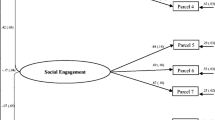Abstract
The internal consistency of the rating sociometric technique commonly used to assess children who might be prone to interpersonal problems later on was determined. The findings question, the use of global indices of sociometric ratings in the examination of preschool peer interactions because they might mask important information about individual dimensions of friendships.
Similar content being viewed by others
References
Gresham F: Conceptual and definitional issues in the assessment of children's social skills: Implications for classification and training.J. Clin. Child Psychol. 15, 3–15, 1986.
Ladd G: Social networks or popula, average, and rejected children in school settings.Merrill-Palmer Quarterly, 29, 283–307, 1983.
Wandlass R, & Prinz R: Methodological issues in conceptualizing and treating childhood social isolation.Psychol Bull. 92, 39–55, 1982.
Furman W, Rahe D, & Hartup W: Rehabilitation of socially withdrawn preschool children through mixed-age and same-age socialization.Child Dev. 50, 915–922. 1979.
Li A: Low peer interaction in kindergarten children: An ecological perspective.J Clini Child Psychol, 15, 26–29, 1986.
Gottman J, & Parkhurst J: A developmental theory of friendship and acquaintanceship process. In A. Collins (Ed.),Minnesota symposium on child psychology. (Vol 13, pp. 197–253). Norwood: Erlbaum, 1980.
Deutsch F: Observational and sociometric measures of peer popularity and their relationship to egocentric communication in female preschoolers.Dev Psychol, 10, 745–747, 1974.
Jennings KD: People versus object orientation, social behavior, and intellectual abilities in children.Dev Psychol, 11, 511–519, 1975.
Walker H: The assessment for integration into mainstream settings (AIMS) assessment system: Rationale, instruments, procedures, and outcomes.J Clin Child Psychol, 15, 55–63, 1986.
Yu P, Harris G, Solovitz B, & Franklin J: A social problem-solving intervention for children at high risk for later psychopathology.J Clin Child Psychol. 15, 30–40, 1986.
Ladd G, & Mize J: A cognitive-social learning model of social skill trainingPsychol Rev, 90, 127–157, 1983.
Putallaz M, & Gottman J: An interactional model of children's entry into peer groups.Child Dev, 52, 986–994, 1981.
Cowen E, Pederson A, Babigian H, Izzo L, & Trost M: Longterm follow-up of early detected vulnerable children.J Con Clin Psychol, 41, 438–446, 1975.
Asher S, & Hymel S: Assessment, with socially isolated and rejected children. In: J. Wine & M. Smye (Eds.),Identification and enhancement of social competence (pp 125–157) 1979. New York: Guilford Press.
Hartup W: Peer relationships. In: E.M. Hetherington (Ed.),Handbook of Child Psychology; Vol 4, (pp. 103–196) 1983. New York: Wiley & Sons.
Roopnarine J, & Field T: Play interactions of friends and acquainatances in nursery school. In: T. Field, J. Roopnarine, M. Segal (Eds.),Friendships in normal and handicapped children (pp 89–98) 1984. Norwood: Ablex.
Hartup W: Peer interaction and social organization. In: P.H. Mussen (Ed.),Carmichael's manual of child psychology (3rd. ed.) (Vol. 2, pp. 361–456). New York: Wiley & Sons, 1970.
Furman W: Children's friendships. In: T. Field, A. Huston, H. Quay, L. Troll, G. Finley (Eds.),Review of human development (pp. 327–339) 1981. New York: Wiley & Sons.
Hartup W, Glazer J, & Charlesworth R: Peer reinforcement and sociometric status.Child Dev, 38, 1017–1024, 1967.
Masters J, Furman W: Popularity, individual friendship selection, and specific peer interaction among children.Dev Psychol, 17, 344–350, 1981.
Furman W, & Masters J: In: collaboration with Rahe, D., Berger, C. An observational manual for coding reinforcing, neutral, and punishing reactions among children. Minneapolis: Institute of Child Development, 1978.
Roopnarine J, & Adams G: The interactional teaching patterns of mothers and fathers with their popular, moderately popular, or unpopular children.J Abnor Child Psychol, 125–135, 1987.
McGrew WC: Aspects of social development in nursery school children, with emphasis on introduction to the group. In: Jones M. Murton (Ed.),Ethological studies of child behavior (pp. 129–156) 1972. London: Cambridge University Press.
Roopnarine J: Changes in peer-directed behavior following preschool experience.J Personality Social Psychol 48, 740–745, 1985.
Asher S, Singleton L, Tinsley B, & Hymel S: A reliable sociometric measure for preschool children.Dev Psychol, 15, 443–444, 1979.
Goldman J: The social participation of preschool children in same-age versus mixed-age groupings.Child Dev, 52, 644–650, 1981.
Selman R:The growth of interpersonal understanding. New York: Academic Press. 1980.
Youniss J: Another perspective on social cognition. In A. Pick (Ed.)Minnesota Symposium on Child Psychology (Vol 9, pp. 173–196). Minneapolis: University of Minnesota Press, 1975.
Author information
Authors and Affiliations
Additional information
The research was supported by the Western Regional Project on Social Competence in Children-W144 at Utah State University. Additional support was provided by the College for Human Development at Syracuse University.
We extend our gratitude to Carala Seamons, Mina Attaran, and Mashid Salehi for their help with the observations.
Rights and permissions
About this article
Cite this article
Roopnarine, J.L., Adams, G.R. & Mounts, N.S. Sociometric status and peer group dynamics. Child Psych Hum Dev 18, 169–180 (1988). https://doi.org/10.1007/BF00709729
Received:
Revised:
Accepted:
Issue Date:
DOI: https://doi.org/10.1007/BF00709729




